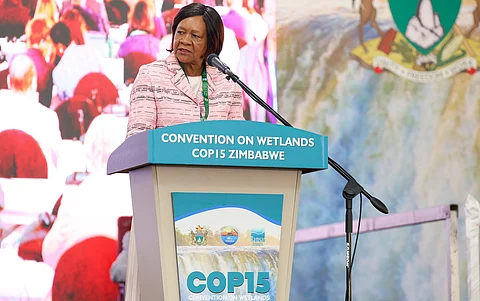Ramsar COP15 closes in Zimbabwe with renewed commitment to wetland conservation
Ramsar COP15 concluded in Zimbabwe with the adoption of resolutions aimed at wetland restoration, protection of migratory birds, and equitable governance.
The conference underscored the importance of political commitment and resource mobilization for wetland conservation, while highlighting the role of indigenous knowledge and local communities in sustainable management.
The curtain came down on the 15th Meeting of the Conference of the Contracting Parties (COP15) to the Ramsar Convention on Wetlands on July 31 evening with the adoption of new resolutions on wetland restoration, the protection of migratory birds and key wetland-dependent species, and the promotion of equitable wetland governance.
The global event, which was held in the Zimbabwean resort city of Victoria Falls, brought together governments, United Nations agencies, scientists, global conservation organisations and representatives of local communities to reaffirm global commitments to the conservation and wise use of wetlands. Running under the theme of Protecting Wetlands for Our Common Future, COP15 provided a critical platform to tackle the rising threats facing freshwater ecosystems and chart a path toward more sustainable management.
A key outcome of COP15 was the Victoria Falls Declaration, which underscores the need for political commitment, increased resource mobilisation, and investment in wetland management.
Resolutions boost wetland restoration and protection
All 13 proposed resolutions were adopted at COP15, signalling what could be a global resolve to protect and restore wetlands. While negotiations were often protracted and complex, in the end notable progress was made on mainstay issues emphasised by all parties and global environmental organisations.
Adopted resolutions include accelerating national and regional actions, enhancing monitoring and reporting, capacity building and mobilisation of resources for wetlands conservation, and mainstreaming the wetlands into climate adaptation and disaster risk reduction, among others.
The 172 contracting parties of the Ramsar Convention also agreed to strengthen flyway conservation efforts to protect migratory birds, endorsed the establishment of the Global Waterbird Estimates Partnership, and recognised the importance of conserving river dolphins and other inland wetland indicator species.
Among the most notable outcomes was the adoption of a resolution on wetland restoration. Parties committed to developing or improving national legislation and policies for the restoration of degraded freshwater ecosystems, in addition to protection and sustainable management, and were invited to consider the Freshwater Challenge as a means to enhance national implementation of the Convention.
A resolution on the application of specific criteria to guide the designation of Wetlands of International Importance was also adopted. These criteria rely heavily on population estimates and ecological data provided by the International Union for Conservation of Nature (IUCN) Red List of Threatened Species and IUCN’s global network of Specialist Groups.
Strategic planning and finance
Two of the most heavily debated topics at COP15 were the Convention on Wetlands 5th Strategic Plan and finance. After protracted negotiations, contracting parties adopted a new strategic plan for the Convention, structured around four goals and 18 targets. The Scientific and Technical Review Panel (STRP) was tasked with developing indicators to monitor progress towards those.
While a clear breakthrough on long-term financing was not reached, Parties did agree on a 4.1 per cent increase in the core budget of the Convention. This brings the total budget for the 2025-2027 triennium to CHF15.5 million ($19.4 million), marking a modest but important step towards reinforcing its operational capacity.
Governance, inclusion and urban wetlands
The parties also adopted a resolution on equitable governance and the effective conservation of wetlands as protected areas and OECMs (Other Effective Area-Based Conservation Measures). This resolution supports more inclusive and rights-based conservation and contributes to broader international targets for area-based protection.
Additional resolutions were adopted on traditional knowledge, youth engagement and the management of urban wetlands, recognising the importance of diverse knowledge systems, intergenerational participation and the role of wetlands in urban sustainability and resilience.
A call to strengthen synergies
In her closing remarks, COP15 President Evelyn Ndlovu urged all contracting parties to embed the commitments of COP15 into their national policies and strategies.
Ndlovu, who is Zimbabwe’s Environment, Climate and Wildlife minister, called for international cooperation and financial mechanisms to close the resource gap for wetland restoration and protection.
“We also call upon strengthening of synergies with other multilateral environmental agencies and agreements to enable us to address complex, interconnected environmental challenges like climate change, plastic and mercury pollution more effectively and efficiently,” she said.
This, she said, would help parties to simplify their collective influence on global environmental protection and improve outcomes for ecosystems and human health, while fostering innovation and shared learning for all.
COP15 draws 3,000 delegates
The Ramsar COP15 conference in Zimbabwe, which ran from July 23-31, and attended by some 3,000 delegates, was the second time that Africa has played host to a Ramsar Convention conference after Uganda hosted COP9 in 2005. COP16 will be hosted by Panama in 2028. Zimbabwe took over the three-year Ramsar Convention on Wetlands presidency from China.
Named after the Iranian city of Ramsar where the inaugural meeting was held in 1971, the Ramsar Convention on Wetlands is an international treaty for the conservation of wetlands of all kinds, notably the 2,531 ‘Ramsar sites’, which are designated wetlands of international importance that cover over 2.6 million square kilometres.
Every three years, representatives of the 172 Ramsar Convention contracting parties meet to discuss the vital role of wetlands in sustaining ecological health, biodiversity, and climate resilience.


